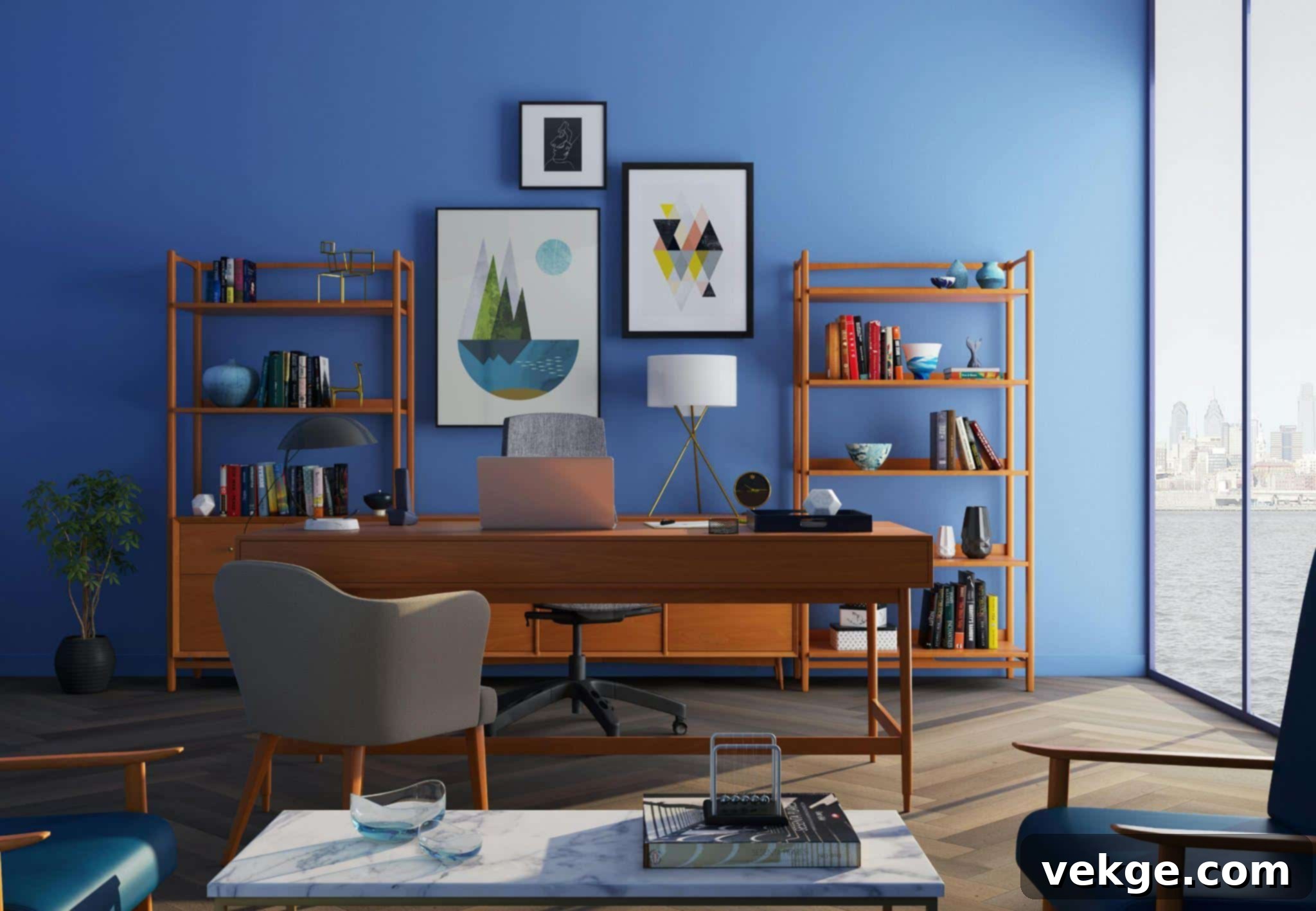The Ultimate Guide to Crafting Your Productive and Ergonomic Home Office
The landscape of professional life has undergone a significant transformation in recent years. What was once considered a temporary or unconventional work arrangement, working from home (WFH) has firmly established itself as a permanent or semi-permanent fixture for millions of professionals worldwide. This paradigm shift has brought with it the imperative for individuals to not just adapt, but to thrive in their home environments. Consequently, setting up a functional, comfortable, and inspiring home office has transitioned from a luxury to a fundamental necessity for maintaining productivity and well-being.
However, diving into the realm of remote work without a strategic approach to your workspace can lead to unforeseen challenges, including decreased efficiency, physical discomfort, and a blurred line between work and personal life. A thoughtfully designed home office is more than just a collection of furniture; it’s an ecosystem designed to foster concentration, support physical health, and promote a healthy work-life integration. To help you navigate this essential journey, here are five crucial considerations that will ensure your home office is not only functional but also a true sanctuary for productivity.
1. Strategically Choose Your Home Office Location

The foundation of any productive home office begins with its location. This decision goes far beyond merely finding an empty corner; it involves identifying a space that actively minimizes distractions, optimizes natural light, and cultivates an environment conducive to deep focus. While a dedicated room undoubtedly offers the most ideal setup for isolation and concentration, it’s not always a feasible option for everyone.
Minimizing Distractions:
Whether you have a spare room or are working within a living area, the key is to select an area that is as far removed as possible from high-traffic household zones. This means avoiding pathways to the kitchen, main living room, or children’s play areas. Consider factors like noise levels from other family members, pets, or outdoor activities. Noise-canceling headphones can be a lifesaver in shared spaces, and strategic placement of furniture or even decorative room dividers can create a psychological boundary for your workspace.
Leveraging Natural Light:
Access to natural light is a powerful productivity booster, known to improve mood, increase energy levels, and reduce eye strain. Position your desk near a window if possible, allowing ample daylight to flood your workspace. However, direct sunlight can be problematic, causing screen glare and overheating. To mitigate this, orient your desk so the window is to your side rather than directly in front or behind you. Invest in adjustable window treatments like blinds or sheer curtains to control light exposure throughout the day, ensuring a comfortable visual environment and maintaining your focus without harsh glares.
Considering Your Background:
For those frequently participating in video calls, your background is an extension of your professional presence. Choose a spot with a clean, uncluttered, and professional-looking backdrop. This might mean a blank wall, a neatly organized bookshelf, or a subtle piece of artwork. Avoid areas with distracting elements, excessive clutter, or high foot traffic behind you, which can detract from your professional image during virtual meetings.
2. Prioritize Ergonomics for Health and Sustained Productivity

Spending prolonged hours in front of a computer screen can take a toll on your body. This makes investing in ergonomic office furniture not just a comfort upgrade, but a critical investment in your long-term health and productivity. Ergonomics is the science of designing and arranging workplaces to fit the user, promoting optimal posture, reducing strain, and preventing musculoskeletal issues.
The Ergonomic Chair: Your Foundation for Comfort
An ergonomic chair is perhaps the single most important piece of furniture in your home office. It should offer robust lumbar support, promoting the natural curve of your spine. Look for adjustable features such as seat height, armrest height and depth, backrest angle, and seat pan depth. These adjustments allow you to tailor the chair to your body, ensuring your feet are flat on the floor (or a footrest), your knees are at a 90-degree angle, and your arms are comfortably supported, reducing strain on your shoulders and wrists.
The Adjustable Desk: Promoting Dynamic Work
Complementing an ergonomic chair is an adjustable desk, ideally one that allows you to effortlessly alternate between sitting and standing positions throughout your workday. The benefits of standing desks are well-documented, including reduced risk of chronic health issues associated with prolonged sitting, such as cardiovascular disease, diabetes, and obesity. Alternating postures also improves circulation, boosts energy levels, and can enhance focus and creativity. When sitting, your desk height should allow your forearms to be parallel to the floor, with your wrists straight while typing. When standing, your monitor should be at eye level, and your elbows should maintain a comfortable 90-degree bend.
Beyond the Chair and Desk: Comprehensive Ergonomic Setup
Don’t stop at the main furniture pieces. Ensure your monitor is at arm’s length and the top of the screen is at eye level, preventing neck strain. Consider a monitor arm for optimal positioning. An ergonomic keyboard and mouse can prevent repetitive strain injuries (RSI) in your wrists and hands. Other accessories like footrests, wrist rests, and proper lighting (discussed later) further contribute to an ergonomically sound workspace.
Navigating the Cost of Ergonomic Furniture:
While the health and productivity benefits of ergonomic furniture are undeniable, the initial cost can sometimes be a barrier. However, there are several practical strategies to make these essential investments more accessible:
- Explore Flexible Financing Options: Companies like CreditNinja offer personal loan solutions that can help individuals invest in high-quality ergonomic furniture without significant upfront financial strain. These lenders often provide tailored payment plans and may be more accommodating to a wider range of credit profiles compared to traditional banks, making ergonomic upgrades achievable within your budget.
- Consider Refurbished or Second-Hand: The market for refurbished or second-hand office furniture is robust. Many businesses liquidate their high-quality furniture during office moves or upgrades, offering excellent ergonomic pieces at significantly reduced prices. Websites, local office liquidators, and even online marketplaces can be great sources for these bargains, allowing you to acquire premium ergonomic benefits at a fraction of the cost.
- Employer Reimbursement or Stipends: Some employers offer stipends or reimbursement programs for home office expenses, including ergonomic furniture. It’s always worth checking with your HR department about any available benefits that can help offset the cost.
- DIY Ergonomic Hacks: If immediate investment isn’t possible, there are temporary solutions. Use books to elevate your monitor, a rolled towel for lumbar support, or a sturdy box as a footrest. While not a substitute for professional ergonomic furniture, these hacks can provide short-term relief.
3. Optimize Your Tech & Connectivity for Seamless Work

In the digital age, your home office is only as efficient as its technological backbone. The right tech and robust connectivity are paramount for maintaining productivity and delivering high-quality work, especially when collaborating remotely.
Powerful Computing Equipment:
Your primary computer (laptop or desktop) should possess adequate processing power, memory (RAM), and storage to comfortably handle your daily workload. For roles involving demanding applications such as graphic design, video editing, software development, or large data analysis, a device with a powerful processor (e.g., Intel i7/Ryzen 7 or higher), ample RAM (16GB+), a dedicated graphics card, and fast SSD storage is highly recommended. For less intensive tasks, a mid-range machine will suffice, but always err on the side of slightly over-specifying to future-proof your setup.
Consider a dual-monitor setup if your work benefits from screen real estate. Two monitors can significantly boost productivity by allowing you to view multiple applications simultaneously without constant alt-tabbing. Ensure your monitors are appropriately sized and positioned ergonomically.
Reliable Internet Connection:
A stable and fast internet connection is non-negotiable for remote work. Slow or intermittent Wi-Fi can lead to frustrating disruptions during video calls, file transfers, and access to cloud-based resources. Assess your current internet plan and consider upgrading to a higher speed package if you experience frequent lag or buffering. For larger homes or areas far from the main router, invest in a mesh Wi-Fi system or Wi-Fi extenders to ensure consistent coverage throughout your workspace. For critical tasks, a wired Ethernet connection directly to your router offers the most reliable and fastest connection, bypassing potential wireless interference.
Essential Peripherals and Software:
- High-Quality Webcam and Microphone: While many laptops have built-in options, an external webcam and microphone often provide superior video and audio clarity, enhancing your professional presence in virtual meetings.
- Backup Solutions: Implement a robust data backup strategy, whether it’s cloud storage, external hard drives, or a combination of both. Data loss can be catastrophic, so preparation is key.
- Security Software: Protect your valuable data and privacy with up-to-date antivirus software, a firewall, and potentially a VPN, especially if handling sensitive company information.
- Productivity Software: Ensure you have all necessary software licenses, from operating systems to specialized applications, securely installed and regularly updated.
4. Master Effective Communication Tools for Remote Collaboration

In a remote work environment, effective communication is the glue that holds teams together. Without the spontaneity of in-person interactions, having a reliable suite of communication tools becomes paramount for seamless collaboration and maintaining strong connections with colleagues and clients alike. These digital tools serve as your lifeline, ensuring that distance doesn’t equate to disconnection.
Core Communication Platforms:
- Video Conferencing: Platforms like Zoom, Microsoft Teams, Google Meet, and Webex are essential for virtual meetings, presentations, and face-to-face interactions. Familiarize yourself with their features, such as screen sharing, virtual backgrounds, and recording options, to maximize their utility.
- Instant Messaging: Tools like Slack, Microsoft Teams chat, or Google Chat provide immediate, informal communication for quick questions, updates, and general team banter. Establish clear guidelines with your team on response times and appropriate usage.
- Project Management Software: Platforms such as Asana, Trello, Monday.com, or Jira help teams track progress, assign tasks, and manage workflows. These tools centralize communication around specific projects, reducing the need for endless email chains.
- Email: While less immediate, email remains crucial for formal communications, documentation, and sharing detailed information. Maintain a professional approach to your email etiquette and organization.
Investing in a High-Quality Headset:
A crucial, yet often overlooked, investment for remote workers is a high-quality headset. This isn’t just about hearing better; it’s about being heard clearly and maintaining focus. A good headset, especially one with noise-canceling capabilities, can drastically improve the clarity of your voice by filtering out background noise from your end. This ensures your message is delivered effectively, reduces misunderstandings, and projects a professional image during calls.
Moreover, wearing a headset can help you stay focused on your conversations and work by minimizing auditory distractions from your own environment. This seemingly small investment has a profound impact on the quality of your virtual interactions, reducing communication fatigue and significantly boosting your overall productivity and engagement with your team. Look for options that are comfortable for long wear, offer clear audio input and output, and ideally include intuitive controls for volume and mute functions.
5. Personalize Your Workspace for Inspiration and Well-being

While functionality and ergonomics are paramount, the aesthetic and emotional connection to your workspace profoundly influence your daily satisfaction, motivation, and overall well-being. Personalizing your home office transforms it from a mere workstation into a dynamic, inspiring environment that reflects your personality and supports your mental health.
Integrate Nature with Plants:
Adding indoor plants is one of the simplest yet most effective ways to personalize your space. Plants not only beautify the area but also introduce a calming natural element. Research suggests that plants can improve air quality, reduce stress, boost mood, and even enhance cognitive performance. Choose low-maintenance varieties like snake plants, ZZ plants, or Pothos if you’re not a seasoned plant parent.
Inspire with Artwork and Decor:
Surround yourself with visual elements that resonate with you. Artwork, photographs, motivational quotes, or even meaningful personal mementos can serve as significant sources of inspiration and motivation. These visual anchors can spark creativity, reinforce your goals, and provide pleasant visual breaks during intense work sessions. Ensure decor is not overly distracting but provides a stimulating backdrop for your thoughts.
Optimize Your Lighting Environment:
Beyond natural light, a well-thought-out lighting scheme is crucial for creating a conducive work environment. Combine different layers of lighting to achieve optimal illumination:
- Task Lighting: A good desk lamp is essential for focused work, reducing eye strain during reading or writing. Look for adjustable lamps that allow you to direct light precisely where needed.
- Ambient Lighting: Overhead lighting or a floor lamp provides general illumination for the room, preventing harsh contrasts between your screen and the surrounding area.
- Accent Lighting: Small lights can highlight decor or artwork, adding depth and warmth to the space.
Consider smart lighting solutions that allow you to adjust color temperature (cooler tones for focus, warmer for relaxation) and brightness throughout the day to match your natural circadian rhythm.
Embrace Organization and Decluttering:
A personalized space is also an organized space. Clutter can be a significant source of stress and distraction. Invest in smart storage solutions like shelves, drawers, and file organizers to keep your workspace tidy. A clean and organized desk signals a clear mind, allowing you to focus on your tasks without visual noise.
Engage Your Senses:
Consider subtle additions that engage other senses. A pleasant, subtle scent from an essential oil diffuser (e.g., peppermint for focus, lavender for calm) can enhance your mood. A comfortable throw blanket or cushion can add a layer of coziness. These small touches contribute to an overall pleasant and inviting atmosphere, making you look forward to stepping into your office each day.
Final Thoughts: Building Your Productive Home Office Sanctuary
Setting up an effective home office is a strategic, multifaceted process that extends far beyond simply finding a spot for your desk. It demands thoughtful consideration of your environment, physical well-being, technological needs, communication strategies, and personal comfort. By meticulously addressing each of these five critical pillars – selecting the right location, prioritizing ergonomics, optimizing technology and connectivity, mastering communication tools, and personalizing your workspace – you lay the groundwork for sustained productivity and professional success.
A well-designed home office is not merely an expense; it is a vital investment in your career, your health, and your overall quality of life as a remote professional. By creating a space that is both highly functional and deeply comfortable, you empower yourself to meet your professional demands with greater efficiency, reduce physical and mental strain, and cultivate a healthier, more balanced work-life integration. Embrace this opportunity to craft a home office sanctuary that truly supports your best work.
